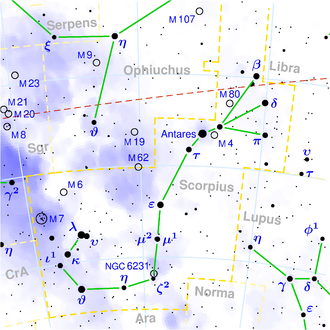Epsilon Scorpii
|
Star ε Scorpii |
|||||||||||||||||||||||
|---|---|---|---|---|---|---|---|---|---|---|---|---|---|---|---|---|---|---|---|---|---|---|---|
| AladinLite | |||||||||||||||||||||||
|
Observation dates equinox : J2000.0 , epoch : J2000.0 |
|||||||||||||||||||||||
| Constellation | Scorpio | ||||||||||||||||||||||
| Right ascension | 16 h 50 m 9.81 s | ||||||||||||||||||||||
| declination | -34 ° 17 ′ 35.6 ″ | ||||||||||||||||||||||
| Apparent brightness | 2.3 mag | ||||||||||||||||||||||
| Typing | |||||||||||||||||||||||
| B − V color index | +1.15 | ||||||||||||||||||||||
| U − B color index | +1.27 | ||||||||||||||||||||||
| R − I index | +0.60 | ||||||||||||||||||||||
| Spectral class | approx.K1 III | ||||||||||||||||||||||
| Astrometry | |||||||||||||||||||||||
| Radial velocity | (−2.5 ± 0.5) km / s | ||||||||||||||||||||||
| parallax | (51.19 ± 0.22) mas | ||||||||||||||||||||||
| distance | (63.71 ± 0.27) Lj (19.54 ± 0.08) pc |
||||||||||||||||||||||
| Proper movement | |||||||||||||||||||||||
| Rec. Share: | (−614.85 ± 0.21) mas / a | ||||||||||||||||||||||
| Dec. portion: | (−255.98 ± 0.13) mas / a | ||||||||||||||||||||||
| Physical Properties | |||||||||||||||||||||||
|
Other names and catalog entries |
|||||||||||||||||||||||
|
|||||||||||||||||||||||
ε Scorpii ( Epsilon Scorpii , short ε Sco ) is a star in the constellation Scorpio, about 64 light years away . ε Scorpii has an apparent visual magnitude of 2.3 and may be as K-giant classified .
The IAU gave this star the name Larawag (a star designation of the Australian natives ) on November 19, 2017 .
Web links
Individual evidence
- ↑ a b c Hipparcos catalog (ESA 1997)
- ↑ a b c Bright Star Catalog
- ↑ Pulkovo radial velocities for 35493 HIP stars
- ↑ a b c Hipparcos, the New Reduction (van Leeuwen, 2007)
- ^ IAU: Naming Stars
- ↑ Stefan Parsch: Xamidimura and Zubenelhakrabi: 86 new star names assigned , on: n-tv online, from December 15, 2017.
